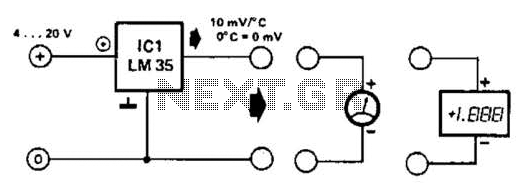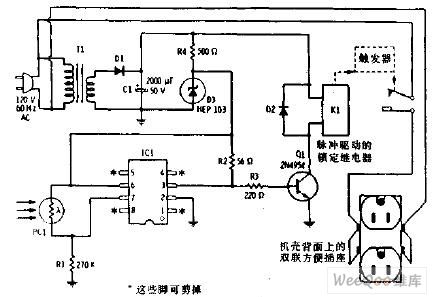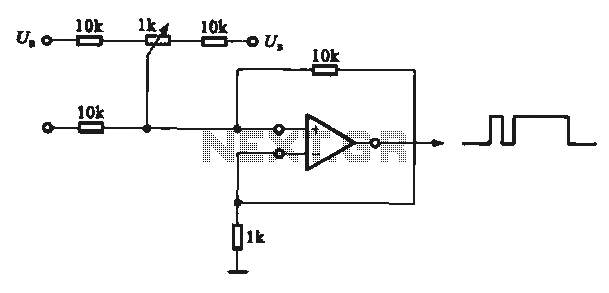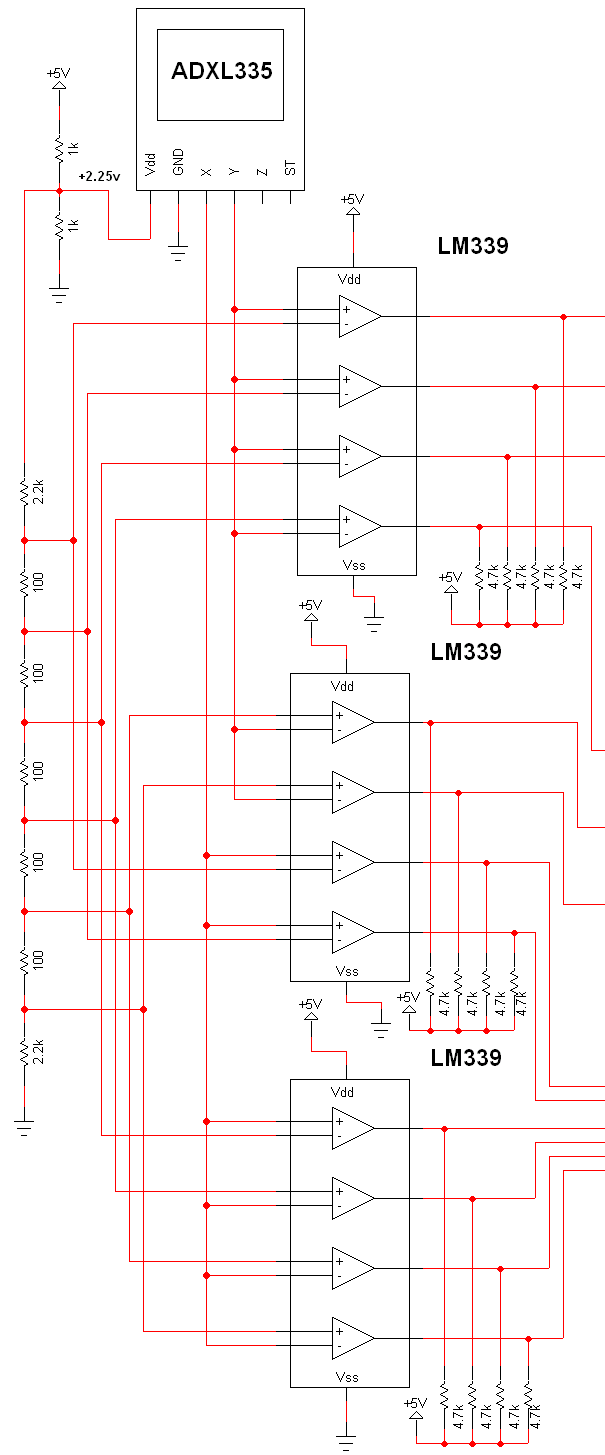
Hook Sensor Loop Circuit

An effective temperature sensor circuit is designed to receive power from a 4-to-20 mA loop without impacting the loop current. The temperature sensor integrated circuit (IC) used is the AD590F, which operates with a supply voltage ranging from 4 V to 40 V DC. The circuit employs a 5-V Zener diode (D1) to regulate the power supplied to the AD590F. Most of the current flows through the Zener diode, while a small current is directed to the AD590F. The device can read temperature information across a resistor (R1), which provides a voltage output of 1 mV/K within a temperature range of -55°C to 150°C. Power loss in this configuration is minimal.
The circuit operates by utilizing the 4-to-20 mA current loop, a common standard in industrial applications for transmitting sensor data. The AD590F temperature sensor is known for its linear output, producing a voltage that is directly proportional to the temperature in Kelvin. The Zener diode serves to stabilize the voltage supplied to the sensor, ensuring consistent operation despite variations in the loop current.
In this configuration, the Zener diode (D1) is selected to maintain a constant voltage of 5 V across the sensor. The current flowing through the diode is significantly higher than that through the AD590F, allowing for minimal interference with the loop current. The resistor (R1) is critical for translating the temperature reading into a measurable voltage, which can be further processed or displayed. The sensitivity of 1 mV/K means that for every degree Kelvin change in temperature, the output voltage changes by 1 mV, facilitating easy integration with data acquisition systems.
The power dissipation in this circuit is kept low due to the efficient operation of the Zener diode and the low current requirements of the AD590F. This design ensures that the temperature sensor can function effectively without drawing excessive power from the loop, thus preserving the integrity of the current signal used for measurement and control in industrial applications. Here`s an effective for a temperature sensor to receive power from a 4-to-20 mA loop without actually affecting the loop current (see the figure). This particular temperature sensor IC (AD590F) conducts 1 / when powered by a supply in the range of 4 V to 40 Vdc.
The scheme uses a 5-V Zener diode (Dl) to regulate the power source for AD590F. Most of the current flows through the Zener diode and a small current flows through AD590F. The device can read the temperature information across Rl, which is a 1 mV/K in the range of-55C to 150C. The waste of power is negligible in this arrangement.
The circuit operates by utilizing the 4-to-20 mA current loop, a common standard in industrial applications for transmitting sensor data. The AD590F temperature sensor is known for its linear output, producing a voltage that is directly proportional to the temperature in Kelvin. The Zener diode serves to stabilize the voltage supplied to the sensor, ensuring consistent operation despite variations in the loop current.
In this configuration, the Zener diode (D1) is selected to maintain a constant voltage of 5 V across the sensor. The current flowing through the diode is significantly higher than that through the AD590F, allowing for minimal interference with the loop current. The resistor (R1) is critical for translating the temperature reading into a measurable voltage, which can be further processed or displayed. The sensitivity of 1 mV/K means that for every degree Kelvin change in temperature, the output voltage changes by 1 mV, facilitating easy integration with data acquisition systems.
The power dissipation in this circuit is kept low due to the efficient operation of the Zener diode and the low current requirements of the AD590F. This design ensures that the temperature sensor can function effectively without drawing excessive power from the loop, thus preserving the integrity of the current signal used for measurement and control in industrial applications. Here`s an effective for a temperature sensor to receive power from a 4-to-20 mA loop without actually affecting the loop current (see the figure). This particular temperature sensor IC (AD590F) conducts 1 / when powered by a supply in the range of 4 V to 40 Vdc.
The scheme uses a 5-V Zener diode (Dl) to regulate the power source for AD590F. Most of the current flows through the Zener diode and a small current flows through AD590F. The device can read the temperature information across Rl, which is a 1 mV/K in the range of-55C to 150C. The waste of power is negligible in this arrangement.





